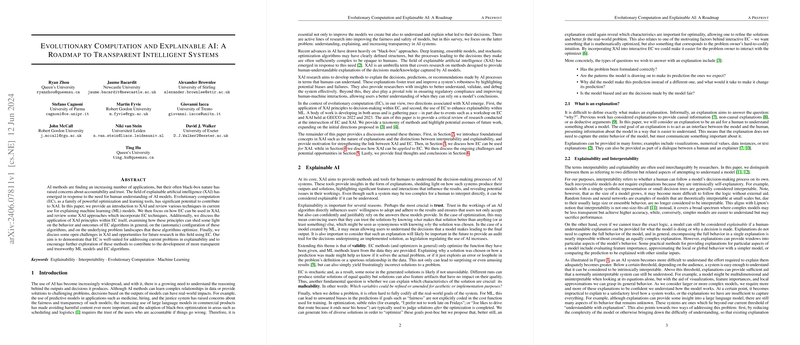Evolutionary Computation and Explainable AI: A Roadmap to Transparent Intelligent Systems
The paper "Evolutionary Computation and Explainable AI: A Roadmap to Transparent Intelligent Systems" by Zhou et al. explores the synergy between evolutionary computation (EC) and explainable artificial intelligence (XAI), proposing a framework to integrate these approaches for building transparent, intelligent systems. The authors provide a detailed survey of XAI techniques, discuss the role EC can play in enhancing explainability, and extend these principles to explaining EC algorithms themselves.
Introduction
The increasing application of AI in various domains necessitates a corresponding need for understanding the decision-making processes of these systems. Traditional "black-box" models like deep learning and ensemble methods often lack transparency, leading to concerns about accountability and trust. The field of XAI aims to mitigate this by developing methods to provide human-understandable explanations of AI models. This paper explores how EC, traditionally used for optimization, can contribute to XAI, and how XAI principles can shed light on the internal workings of EC algorithms.
Explainable AI
XAI encompasses a range of methods designed to elucidate the decision-making processes of AI systems. These methods are critical for fostering trust, improving robustness, and ensuring compliance with regulatory standards. The authors distinguish between interpretability, where a model's decision-making process is inherently understandable, and explainability, where additional methods provide insights into a model's behavior.
EC for XAI
EC methods, including genetic algorithms (GA), genetic programming (GP), and evolution strategies (ES), are presented as effective tools for enhancing XAI. EC's flexibility and ability to optimize complex, non-differentiable metrics make it well-suited for generating interpretable models and explanations.
Interpretability by Design
EC methods can evolve interpretable models by leveraging rule-based representations or symbolic expressions. Hybrid approaches, combining EC with reinforcement learning (RL) or local search methods, can further improve the generated models' interpretability.
Explaining Data and Preprocessing
Dimensionality reduction and feature selection/engineering are crucial preprocessing steps that can be enhanced through EC. Techniques such as GP-tSNE and multi-objective GP-based methods for feature construction can create interpretable embeddings and features, improving both model performance and interpretability.
Explaining Model Behavior
The authors discuss methods for understanding a model's internal workings, including feature importance and global model approximations. EC can be used to generate surrogate models that approximate complex black-box models while being more interpretable. Additionally, methods for explaining neural networks, such as evolving interpretable representations of latent spaces, are highlighted.
Explaining Predictions
Local explanations and counterfactual examples are methods that can provide insights into specific predictions. EC's capability to optimize multiple objectives makes it suitable for generating diverse and proximal counterfactual examples. Adversarial examples, which expose vulnerabilities in models, can also be generated using EC, aiding in understanding a model's failure modes.
Assessing Explanations
Evaluating the robustness and quality of explanations is another area where EC can contribute. The paper cites methods for measuring the robustness of interpretations and adversarial attacks on explanations, emphasizing the need for rigorous evaluation to ensure the explanations' validity.
XAI for EC
The paper also explores how XAI principles can be applied to EC methods to improve their transparency. This includes explaining problem landscapes, user-guided evolution, and visualizing solutions.
Landscape Analysis and Trajectories
Understanding the search space and the trajectory of EC algorithms can provide insights into their behavior. Techniques such as search trajectory networks and surrogate models are discussed as tools for analyzing EC algorithms' progress and decision-making processes.
Interacting with Users
Incorporating user feedback and interactivity into the evolutionary search process can enhance trust and tailor solutions to user preferences. Quality-diversity algorithms, such as MAP-Elites, are proposed as methods for generating diverse, high-quality solutions that can be more easily understood by users.
Visualizing Solutions
Visualization techniques, especially for multi-objective optimization, are crucial for interpreting the solutions provided by EC algorithms. Methods for reducing the dimensionality of objective spaces and enhancing parallel coordinate plots are highlighted as valuable tools for aiding decision-makers.
Research Outlook
The authors identify several challenges and opportunities for future research in integrating EC and XAI. Scalability remains a significant challenge due to the growing complexity of models and datasets. Incorporating domain knowledge and user feedback into the explanation process is also seen as a critical area for development. The potential for multi-objective optimization and quality-diversity approaches to enhance explainability is emphasized as a promising direction for future research.
Conclusion
The paper provides a comprehensive roadmap for integrating EC and XAI, emphasizing the mutual benefits of these approaches. By leveraging EC's optimization capabilities, XAI can generate more interpretable and trustworthy models. Conversely, XAI principles can improve the transparency of EC algorithms, fostering better understanding and trust in their solutions. As AI continues to permeate various domains, the integration of EC and XAI holds significant promise for developing more transparent, accountable, and reliable intelligent systems.
